Case Study: Analyzing Cultural Dynamics in Sports Management
VerifiedAdded on 2023/06/11
|7
|1522
|215
Case Study
AI Summary
This case study explores organizational culture within sports management, focusing on swimming in the USA and Australia, and Australian Football League (AFL). It examines how national culture influences sports organizations and how governing bodies address dysfunctional behaviors. The analysis includes a review of Swimming Australia's practices, emphasizing the importance of athlete behavior, social media policies, and accountability. The study also discusses how traditional sports like AFL respond to social change by embracing diversity and equality. Furthermore, it highlights AFL's strategies for communicating cultural values to stakeholders through various channels, including cultural awareness programs and community ambassadors. The document provides a comprehensive look at the challenges and strategies involved in managing and evolving organizational culture in the sports industry.
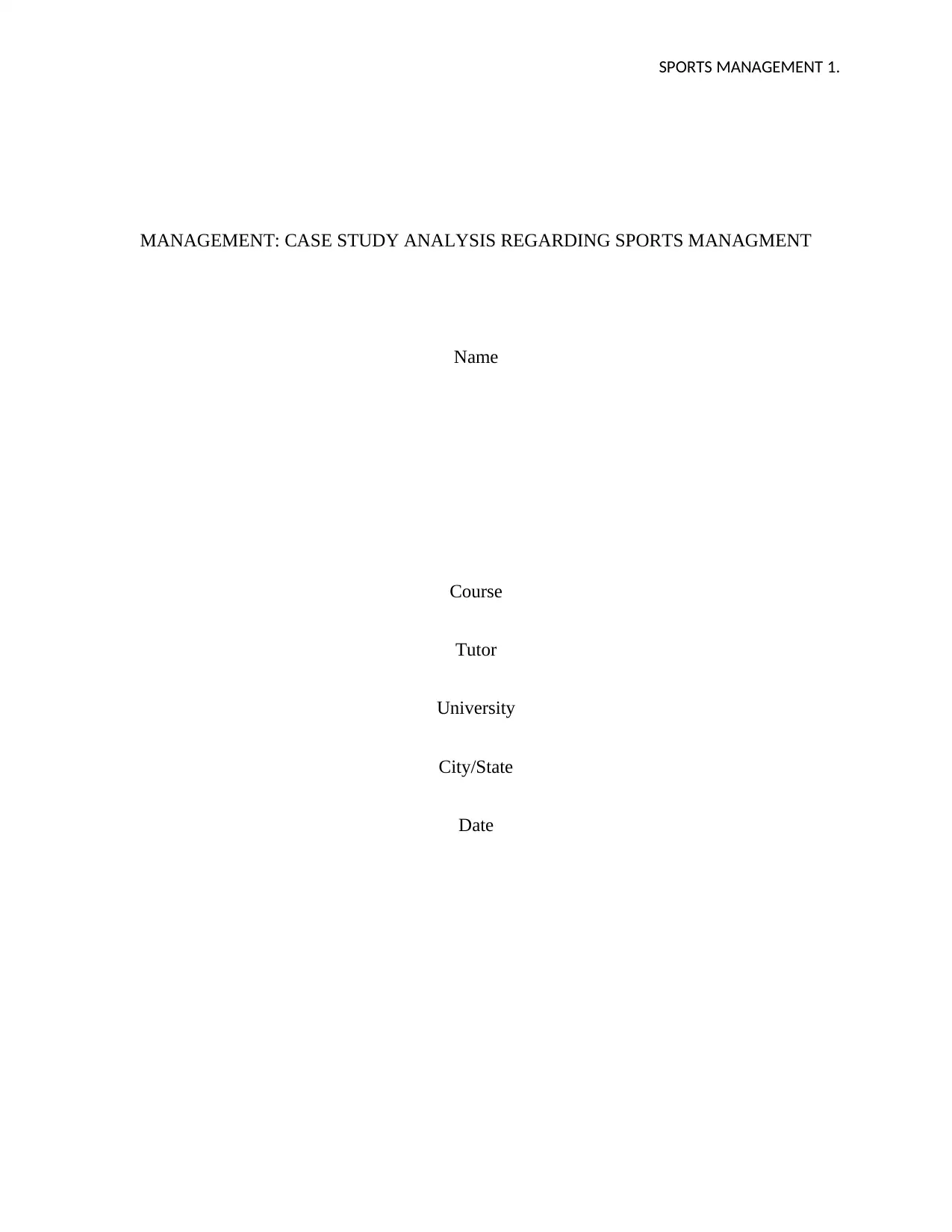
SPORTS MANAGEMENT 1.
MANAGEMENT: CASE STUDY ANALYSIS REGARDING SPORTS MANAGMENT
Name
Course
Tutor
University
City/State
Date
MANAGEMENT: CASE STUDY ANALYSIS REGARDING SPORTS MANAGMENT
Name
Course
Tutor
University
City/State
Date
Paraphrase This Document
Need a fresh take? Get an instant paraphrase of this document with our AI Paraphraser
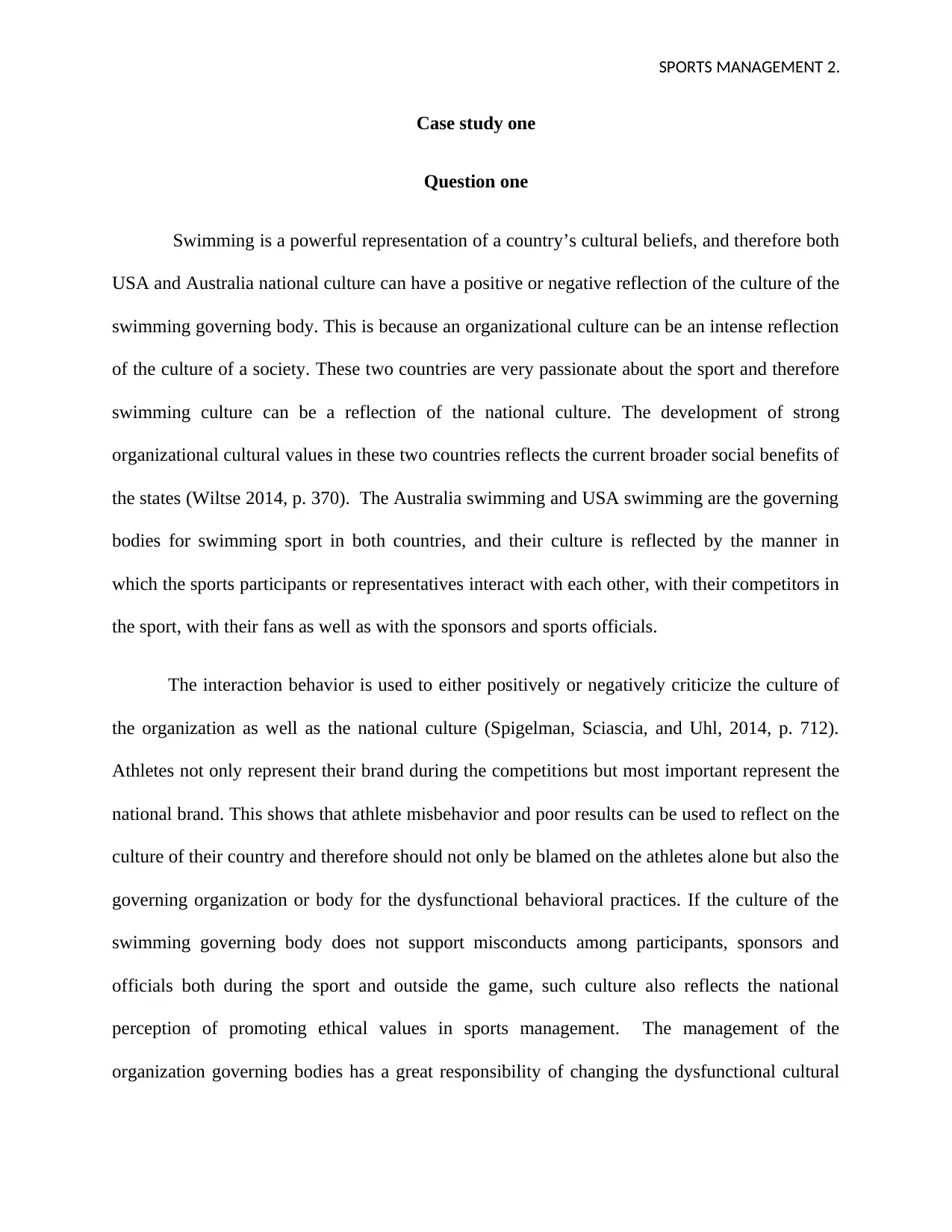
SPORTS MANAGEMENT 2.
Case study one
Question one
Swimming is a powerful representation of a country’s cultural beliefs, and therefore both
USA and Australia national culture can have a positive or negative reflection of the culture of the
swimming governing body. This is because an organizational culture can be an intense reflection
of the culture of a society. These two countries are very passionate about the sport and therefore
swimming culture can be a reflection of the national culture. The development of strong
organizational cultural values in these two countries reflects the current broader social benefits of
the states (Wiltse 2014, p. 370). The Australia swimming and USA swimming are the governing
bodies for swimming sport in both countries, and their culture is reflected by the manner in
which the sports participants or representatives interact with each other, with their competitors in
the sport, with their fans as well as with the sponsors and sports officials.
The interaction behavior is used to either positively or negatively criticize the culture of
the organization as well as the national culture (Spigelman, Sciascia, and Uhl, 2014, p. 712).
Athletes not only represent their brand during the competitions but most important represent the
national brand. This shows that athlete misbehavior and poor results can be used to reflect on the
culture of their country and therefore should not only be blamed on the athletes alone but also the
governing organization or body for the dysfunctional behavioral practices. If the culture of the
swimming governing body does not support misconducts among participants, sponsors and
officials both during the sport and outside the game, such culture also reflects the national
perception of promoting ethical values in sports management. The management of the
organization governing bodies has a great responsibility of changing the dysfunctional cultural
Case study one
Question one
Swimming is a powerful representation of a country’s cultural beliefs, and therefore both
USA and Australia national culture can have a positive or negative reflection of the culture of the
swimming governing body. This is because an organizational culture can be an intense reflection
of the culture of a society. These two countries are very passionate about the sport and therefore
swimming culture can be a reflection of the national culture. The development of strong
organizational cultural values in these two countries reflects the current broader social benefits of
the states (Wiltse 2014, p. 370). The Australia swimming and USA swimming are the governing
bodies for swimming sport in both countries, and their culture is reflected by the manner in
which the sports participants or representatives interact with each other, with their competitors in
the sport, with their fans as well as with the sponsors and sports officials.
The interaction behavior is used to either positively or negatively criticize the culture of
the organization as well as the national culture (Spigelman, Sciascia, and Uhl, 2014, p. 712).
Athletes not only represent their brand during the competitions but most important represent the
national brand. This shows that athlete misbehavior and poor results can be used to reflect on the
culture of their country and therefore should not only be blamed on the athletes alone but also the
governing organization or body for the dysfunctional behavioral practices. If the culture of the
swimming governing body does not support misconducts among participants, sponsors and
officials both during the sport and outside the game, such culture also reflects the national
perception of promoting ethical values in sports management. The management of the
organization governing bodies has a great responsibility of changing the dysfunctional cultural
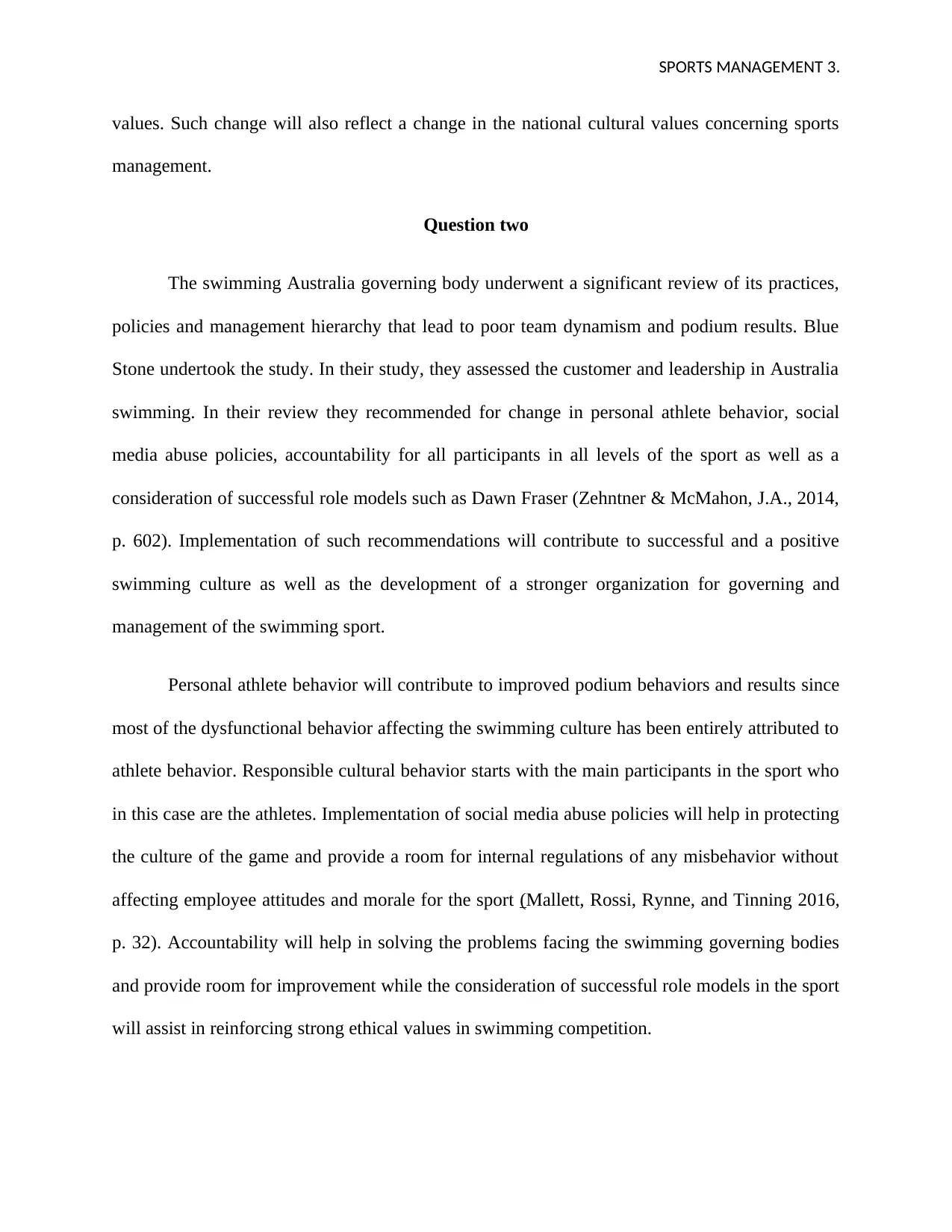
SPORTS MANAGEMENT 3.
values. Such change will also reflect a change in the national cultural values concerning sports
management.
Question two
The swimming Australia governing body underwent a significant review of its practices,
policies and management hierarchy that lead to poor team dynamism and podium results. Blue
Stone undertook the study. In their study, they assessed the customer and leadership in Australia
swimming. In their review they recommended for change in personal athlete behavior, social
media abuse policies, accountability for all participants in all levels of the sport as well as a
consideration of successful role models such as Dawn Fraser (Zehntner & McMahon, J.A., 2014,
p. 602). Implementation of such recommendations will contribute to successful and a positive
swimming culture as well as the development of a stronger organization for governing and
management of the swimming sport.
Personal athlete behavior will contribute to improved podium behaviors and results since
most of the dysfunctional behavior affecting the swimming culture has been entirely attributed to
athlete behavior. Responsible cultural behavior starts with the main participants in the sport who
in this case are the athletes. Implementation of social media abuse policies will help in protecting
the culture of the game and provide a room for internal regulations of any misbehavior without
affecting employee attitudes and morale for the sport (Mallett, Rossi, Rynne, and Tinning 2016,
p. 32). Accountability will help in solving the problems facing the swimming governing bodies
and provide room for improvement while the consideration of successful role models in the sport
will assist in reinforcing strong ethical values in swimming competition.
values. Such change will also reflect a change in the national cultural values concerning sports
management.
Question two
The swimming Australia governing body underwent a significant review of its practices,
policies and management hierarchy that lead to poor team dynamism and podium results. Blue
Stone undertook the study. In their study, they assessed the customer and leadership in Australia
swimming. In their review they recommended for change in personal athlete behavior, social
media abuse policies, accountability for all participants in all levels of the sport as well as a
consideration of successful role models such as Dawn Fraser (Zehntner & McMahon, J.A., 2014,
p. 602). Implementation of such recommendations will contribute to successful and a positive
swimming culture as well as the development of a stronger organization for governing and
management of the swimming sport.
Personal athlete behavior will contribute to improved podium behaviors and results since
most of the dysfunctional behavior affecting the swimming culture has been entirely attributed to
athlete behavior. Responsible cultural behavior starts with the main participants in the sport who
in this case are the athletes. Implementation of social media abuse policies will help in protecting
the culture of the game and provide a room for internal regulations of any misbehavior without
affecting employee attitudes and morale for the sport (Mallett, Rossi, Rynne, and Tinning 2016,
p. 32). Accountability will help in solving the problems facing the swimming governing bodies
and provide room for improvement while the consideration of successful role models in the sport
will assist in reinforcing strong ethical values in swimming competition.
⊘ This is a preview!⊘
Do you want full access?
Subscribe today to unlock all pages.

Trusted by 1+ million students worldwide
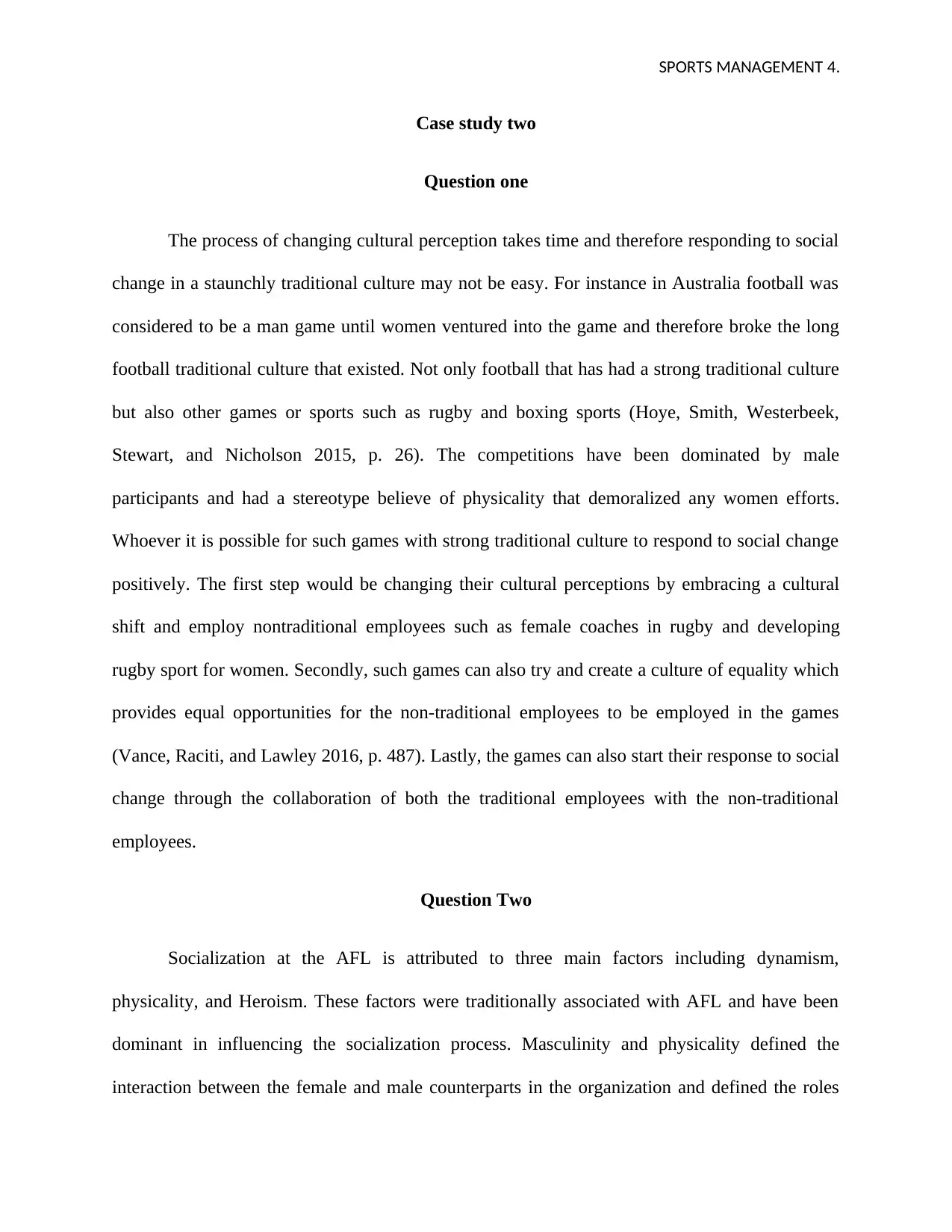
SPORTS MANAGEMENT 4.
Case study two
Question one
The process of changing cultural perception takes time and therefore responding to social
change in a staunchly traditional culture may not be easy. For instance in Australia football was
considered to be a man game until women ventured into the game and therefore broke the long
football traditional culture that existed. Not only football that has had a strong traditional culture
but also other games or sports such as rugby and boxing sports (Hoye, Smith, Westerbeek,
Stewart, and Nicholson 2015, p. 26). The competitions have been dominated by male
participants and had a stereotype believe of physicality that demoralized any women efforts.
Whoever it is possible for such games with strong traditional culture to respond to social change
positively. The first step would be changing their cultural perceptions by embracing a cultural
shift and employ nontraditional employees such as female coaches in rugby and developing
rugby sport for women. Secondly, such games can also try and create a culture of equality which
provides equal opportunities for the non-traditional employees to be employed in the games
(Vance, Raciti, and Lawley 2016, p. 487). Lastly, the games can also start their response to social
change through the collaboration of both the traditional employees with the non-traditional
employees.
Question Two
Socialization at the AFL is attributed to three main factors including dynamism,
physicality, and Heroism. These factors were traditionally associated with AFL and have been
dominant in influencing the socialization process. Masculinity and physicality defined the
interaction between the female and male counterparts in the organization and defined the roles
Case study two
Question one
The process of changing cultural perception takes time and therefore responding to social
change in a staunchly traditional culture may not be easy. For instance in Australia football was
considered to be a man game until women ventured into the game and therefore broke the long
football traditional culture that existed. Not only football that has had a strong traditional culture
but also other games or sports such as rugby and boxing sports (Hoye, Smith, Westerbeek,
Stewart, and Nicholson 2015, p. 26). The competitions have been dominated by male
participants and had a stereotype believe of physicality that demoralized any women efforts.
Whoever it is possible for such games with strong traditional culture to respond to social change
positively. The first step would be changing their cultural perceptions by embracing a cultural
shift and employ nontraditional employees such as female coaches in rugby and developing
rugby sport for women. Secondly, such games can also try and create a culture of equality which
provides equal opportunities for the non-traditional employees to be employed in the games
(Vance, Raciti, and Lawley 2016, p. 487). Lastly, the games can also start their response to social
change through the collaboration of both the traditional employees with the non-traditional
employees.
Question Two
Socialization at the AFL is attributed to three main factors including dynamism,
physicality, and Heroism. These factors were traditionally associated with AFL and have been
dominant in influencing the socialization process. Masculinity and physicality defined the
interaction between the female and male counterparts in the organization and defined the roles
Paraphrase This Document
Need a fresh take? Get an instant paraphrase of this document with our AI Paraphraser
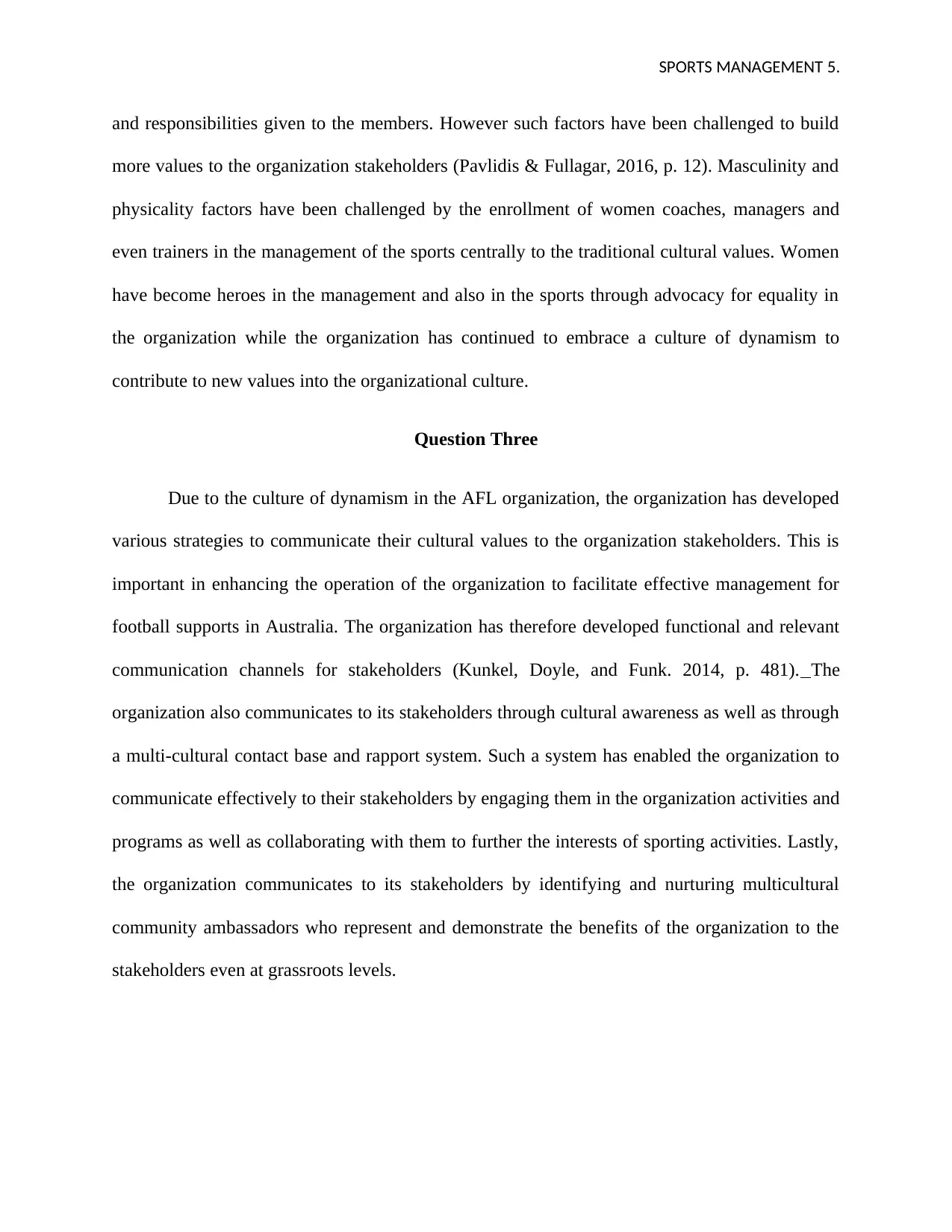
SPORTS MANAGEMENT 5.
and responsibilities given to the members. However such factors have been challenged to build
more values to the organization stakeholders (Pavlidis & Fullagar, 2016, p. 12). Masculinity and
physicality factors have been challenged by the enrollment of women coaches, managers and
even trainers in the management of the sports centrally to the traditional cultural values. Women
have become heroes in the management and also in the sports through advocacy for equality in
the organization while the organization has continued to embrace a culture of dynamism to
contribute to new values into the organizational culture.
Question Three
Due to the culture of dynamism in the AFL organization, the organization has developed
various strategies to communicate their cultural values to the organization stakeholders. This is
important in enhancing the operation of the organization to facilitate effective management for
football supports in Australia. The organization has therefore developed functional and relevant
communication channels for stakeholders (Kunkel, Doyle, and Funk. 2014, p. 481). The
organization also communicates to its stakeholders through cultural awareness as well as through
a multi-cultural contact base and rapport system. Such a system has enabled the organization to
communicate effectively to their stakeholders by engaging them in the organization activities and
programs as well as collaborating with them to further the interests of sporting activities. Lastly,
the organization communicates to its stakeholders by identifying and nurturing multicultural
community ambassadors who represent and demonstrate the benefits of the organization to the
stakeholders even at grassroots levels.
and responsibilities given to the members. However such factors have been challenged to build
more values to the organization stakeholders (Pavlidis & Fullagar, 2016, p. 12). Masculinity and
physicality factors have been challenged by the enrollment of women coaches, managers and
even trainers in the management of the sports centrally to the traditional cultural values. Women
have become heroes in the management and also in the sports through advocacy for equality in
the organization while the organization has continued to embrace a culture of dynamism to
contribute to new values into the organizational culture.
Question Three
Due to the culture of dynamism in the AFL organization, the organization has developed
various strategies to communicate their cultural values to the organization stakeholders. This is
important in enhancing the operation of the organization to facilitate effective management for
football supports in Australia. The organization has therefore developed functional and relevant
communication channels for stakeholders (Kunkel, Doyle, and Funk. 2014, p. 481). The
organization also communicates to its stakeholders through cultural awareness as well as through
a multi-cultural contact base and rapport system. Such a system has enabled the organization to
communicate effectively to their stakeholders by engaging them in the organization activities and
programs as well as collaborating with them to further the interests of sporting activities. Lastly,
the organization communicates to its stakeholders by identifying and nurturing multicultural
community ambassadors who represent and demonstrate the benefits of the organization to the
stakeholders even at grassroots levels.
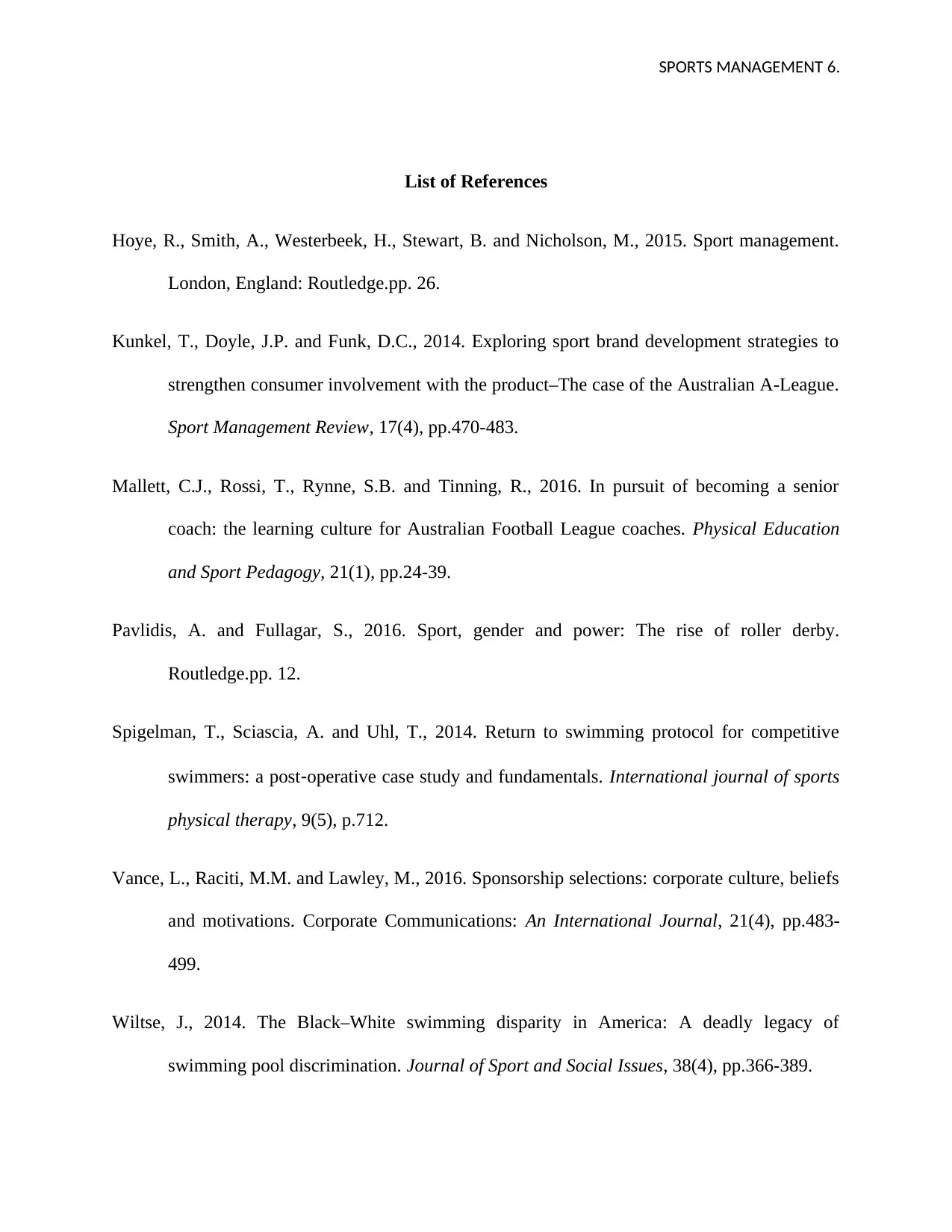
SPORTS MANAGEMENT 6.
List of References
Hoye, R., Smith, A., Westerbeek, H., Stewart, B. and Nicholson, M., 2015. Sport management.
London, England: Routledge.pp. 26.
Kunkel, T., Doyle, J.P. and Funk, D.C., 2014. Exploring sport brand development strategies to
strengthen consumer involvement with the product–The case of the Australian A-League.
Sport Management Review, 17(4), pp.470-483.
Mallett, C.J., Rossi, T., Rynne, S.B. and Tinning, R., 2016. In pursuit of becoming a senior
coach: the learning culture for Australian Football League coaches. Physical Education
and Sport Pedagogy, 21(1), pp.24-39.
Pavlidis, A. and Fullagar, S., 2016. Sport, gender and power: The rise of roller derby.
Routledge.pp. 12.
Spigelman, T., Sciascia, A. and Uhl, T., 2014. Return to swimming protocol for competitive
swimmers: a post‐operative case study and fundamentals. International journal of sports
physical therapy, 9(5), p.712.
Vance, L., Raciti, M.M. and Lawley, M., 2016. Sponsorship selections: corporate culture, beliefs
and motivations. Corporate Communications: An International Journal, 21(4), pp.483-
499.
Wiltse, J., 2014. The Black–White swimming disparity in America: A deadly legacy of
swimming pool discrimination. Journal of Sport and Social Issues, 38(4), pp.366-389.
List of References
Hoye, R., Smith, A., Westerbeek, H., Stewart, B. and Nicholson, M., 2015. Sport management.
London, England: Routledge.pp. 26.
Kunkel, T., Doyle, J.P. and Funk, D.C., 2014. Exploring sport brand development strategies to
strengthen consumer involvement with the product–The case of the Australian A-League.
Sport Management Review, 17(4), pp.470-483.
Mallett, C.J., Rossi, T., Rynne, S.B. and Tinning, R., 2016. In pursuit of becoming a senior
coach: the learning culture for Australian Football League coaches. Physical Education
and Sport Pedagogy, 21(1), pp.24-39.
Pavlidis, A. and Fullagar, S., 2016. Sport, gender and power: The rise of roller derby.
Routledge.pp. 12.
Spigelman, T., Sciascia, A. and Uhl, T., 2014. Return to swimming protocol for competitive
swimmers: a post‐operative case study and fundamentals. International journal of sports
physical therapy, 9(5), p.712.
Vance, L., Raciti, M.M. and Lawley, M., 2016. Sponsorship selections: corporate culture, beliefs
and motivations. Corporate Communications: An International Journal, 21(4), pp.483-
499.
Wiltse, J., 2014. The Black–White swimming disparity in America: A deadly legacy of
swimming pool discrimination. Journal of Sport and Social Issues, 38(4), pp.366-389.
⊘ This is a preview!⊘
Do you want full access?
Subscribe today to unlock all pages.

Trusted by 1+ million students worldwide

SPORTS MANAGEMENT 7.
Zehntner, C. and McMahon, J.A., 2014. Mentoring in coaching: the means of correct training?
An autoethnographic exploration of one Australian swimming coach’s experiences.
Qualitative research in sport, exercise and health, 6(4), pp.596-616.
Zehntner, C. and McMahon, J.A., 2014. Mentoring in coaching: the means of correct training?
An autoethnographic exploration of one Australian swimming coach’s experiences.
Qualitative research in sport, exercise and health, 6(4), pp.596-616.
1 out of 7
Related Documents
Your All-in-One AI-Powered Toolkit for Academic Success.
+13062052269
info@desklib.com
Available 24*7 on WhatsApp / Email
![[object Object]](/_next/static/media/star-bottom.7253800d.svg)
Unlock your academic potential
Copyright © 2020–2025 A2Z Services. All Rights Reserved. Developed and managed by ZUCOL.





